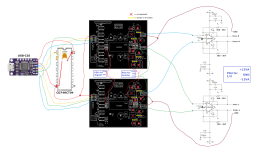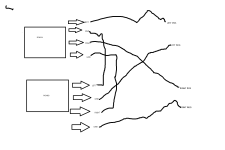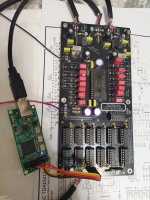@Cooper60hz Miro once detailed a circuit with two of his DACs using differential op amps -

abraxalito also does a phase inverter module to split I2S between DAC boards.

abraxalito also does a phase inverter module to split I2S between DAC boards.
Hi arteom,Hi Everyone. A few months back I felt like selling out a bit, took up an offer form Burson to try a set of their opamps - given to me as a samples in exchange for an honest writeup. Below is a comparison between a set of Burson V7 Vivid's, OPA627's, and OPA1655's. Initially I planned to use the set I received from Burson for the miroAD1862 DAC, but had little idea of their size. When they arrived I found the caps in the way, about 30 minutes after heating up my soldering iron and getting out soldering wick I said nuts to that. There was an already built miroTDA1541A set of boards on the marketplace which I picked up, it had the offending caps on the underside 🙂. I cased and powered that, originally using the waveIO board. Soon I noticed odd artifacts with that setup. Recently got the jlsounds board, setup using two external power supply method. The rest of my system is a ZM Iron Pre SE, and a Pass F6 clone. Speakers used for testing were a set of Dahlquist DQM-9C's, which I've found to be very revealing.
Marcus Wyatt & The ZAR Jazz Orchestra - Into dust - Show You
OPA627 - Natural, cohesive. Everyone on the same stage. No sense of anything missing.
Burson V7 Vivid- More space between instruments. Some energy imparted to the sound, snappier sense of attack and decay. More detail overall.
OPA1655 - First thought I had as I turned it on was that it's a bit lean and boring compared to the two above. But nothing terribly wrong with it, nice sense of dynamics, though at the same time not as lively.
Mariam Matossian - In the Light - Narineh
Mariam has a lovely voice that is a very soft and airy, however the recording is at times not optimal - with a sort of hardness present in the upper mids.
OPA1655 - Nice sense of softness, dynamics.
OPA627 - Fuller midrange compared to the 1655, more forward. Good sense of rhythm and swing (this not exactly swinging jazz music here).
Burson V7 Vivid - More open, better sense of space and reverberation of the vocals. A bit of a sizzle to the guitar in a very nice way. The same effect highlights the hardness in the vocal, tolerable but at time bordering on grating.
Murcof - Cosmos - Cuerpo Celeste
This is like a space opera well deserving of the album title. Essentially electronic, but crosses into modern classical spaces here and there.
Burson V7 Vivid- A very strong sound, open, brassy, not over the top in any sense. Solid bottom end and well detailed in higher frequencies. Really shows what it can do in this track.
OPA1655 - the quietness of this opamp gives a nice sense of movement in the stereo image. A good sense of space, the ringing effect of the instruments. The bass is not unsatisfactory, but not at the level of the other two.
OPA627 - Missing the big bottom end of the Burson. It excels in presenting everything in a cohesive manner, all elements are interacting with each other on a single stage, at times crossing each other's space. Perhaps a bit too laid back for this track and lacking details up top.
The Burson Vivid scored well overall. Highly detailed, solid bottom end, lots of space between instruments. They can bring out some upper-mid energy in the music, almost like a filter which has "drive" turned up a notch or two. It gives them a lively nature, but can be a bit much with some recordings. I found it to excel with electronic music, and give a nice sizzle to guitars and (well recorded) horns. At some point I might pickup a set of their "Classic's," see how they compare.
The OPA627 is easy to live with. What I liked about it is a sense of cohesiveness to the recording. The Burson's did well in giving more space around instruments but this at time made them sound like they were playing in a space separate from the other instruments. The 627's were more natural in this regard. I should say the Burson's were on the DAC for a week straight, I did not have this impression at all until I plugged in the 627's. They (the 627's) are a bit round on the edges, and might accentuate the warm and fuzzy bits of the TDA1541A a bit too much.
OPA1655 in one word - polite. Its midrange is a bit sucked out. It can be involving at best, drawing in the listener, asking them to tune in. At worst, it's lean and uninteresting. This was especially highlighted when I plugged either of the other two opamps. I was generally pleasantly surprised by it, it has its own character.
Thank you for sending us the photo of your project. We are sharing it with the DIY-Audio community.
You need to use flip flop/inverter to invert the signal for the second dac. You cannot do it as is. Especially nit like you drew it 🙂 passive has attached a drawing up above your post.So just to confirm this wont work?
Wow man, can it fly in outer space? 😆Hi arteom,
Thank you for sending us the photo of your project. We are sharing it with the DIY-Audio community.
View attachment 1352258
Lads, what's the rationale behind a full balanced diy dac? (passive, you already gave me an exhaustive answer, so you do not need to 😉) Are you getting a little caught up with this dac ? 😆😆😆😆😆@Cooper60hz Miro once detailed a circuit with two of his DACs using differential op amps -
View attachment 1352243
abraxalito also does a phase inverter module to split I2S between DAC boards.
Maybe if I can get another transformer in there 🤔..Wow man, can it fly in outer space? 😆
Hello
I have built miro dac TDA1541 and put TDA1541 NON A version on device without C15 cap.
I used wima 470np for decoupling cap.
i played music after set trimmer to 0v , midrange and low frequency is fine and clean on speakers but high frequency have jitter and a bit pink noise.
after check the usb module for set bit depth on 16 bit i seen that 24 and 32 bit supported.
I used this usb module:
Link
USB GND - DAC GND
USB DATA - DAC DATA
USB BCLK - DAC BCK
USB LRCK - DAC LRCK
PLEASE HELP ME ?😁
I have built miro dac TDA1541 and put TDA1541 NON A version on device without C15 cap.
I used wima 470np for decoupling cap.
i played music after set trimmer to 0v , midrange and low frequency is fine and clean on speakers but high frequency have jitter and a bit pink noise.
after check the usb module for set bit depth on 16 bit i seen that 24 and 32 bit supported.
I used this usb module:
Link
USB GND - DAC GND
USB DATA - DAC DATA
USB BCLK - DAC BCK
USB LRCK - DAC LRCK
PLEASE HELP ME ?😁
Attachments
Hi,
connections are fine. If you use materials with more than 16 bits, it works, the DAC will just read the first 16 bits w/o consequences.
Problrm is certainly eslwhere. For instance a noisy smps source before the USB (pc ?). But it can be anything. Proceed with try and errors. Has the chip being tested elswhere before ? Another chip to try.
Picture can help to debug the hardwares layout .
connections are fine. If you use materials with more than 16 bits, it works, the DAC will just read the first 16 bits w/o consequences.
Problrm is certainly eslwhere. For instance a noisy smps source before the USB (pc ?). But it can be anything. Proceed with try and errors. Has the chip being tested elswhere before ? Another chip to try.
Picture can help to debug the hardwares layout .
I wonder what is a suitable I2S converter that you can use to skip the shift registers? (I'm a bit afraid to solder those)PCB v1.3 (pad)
The same as PCB v1.3 in post #1278, except:
- the Vout pin on I2S header is removed (@diyiggy)
- added pins for a direct drive without shift registers with a suitable I2S converter (break JP1, JP2) (@Vunce)
JLSounds boards or IanCanada I2StoPCM board (must be feed from a Masterclock though for this last).
Shift registers are easy to solder if you use flux. Just need a magnyfing glass.
Shift registers are easy to solder if you use flux. Just need a magnyfing glass.
The JLSounds is the simplest and most direct solution because it is USB-I2S interface + outputs your required signals to the DAC without the need of the shift registers.
If you use the Ian canada i2s to PCM board, you will still need to invest in a USB-I2S interface, if your plan is to take a USB output from a source.
If you use the Ian canada i2s to PCM board, you will still need to invest in a USB-I2S interface, if your plan is to take a USB output from a source.
If you have the USB-I2S interface in your drawer, it can be used with a CPLD with the program to output the required signals to the DAC too, skipping the shift registers.
https://electrodac.blogspot.com/p/i2s-to-pcm-dac-converter-tutorial-cpld.html
It is easy with Miro's tutorial.
https://electrodac.blogspot.com/p/i2s-to-pcm-dac-converter-tutorial-cpld.html
It is easy with Miro's tutorial.
I use iMac and audirvana.Hi,
connections are fine. If you use materials with more than 16 bits, it works, the DAC will just read the first 16 bits w/o consequences.
Problrm is certainly eslwhere. For instance a noisy smps source before the USB (pc ?). But it can be anything. Proceed with try and errors. Has the chip being tested elswhere before ? Another chip to try.
Picture can help to debug the hardwares layout .
try 4 qty TDA1541 chip and problem is there.
now dc offset on left output not changing and is 0.8v.
Attachments
From the last picture on your link, a simple usb/I2S board can be use? Or does a fancier one give better performance?If you have the USB-I2S interface in your drawer, it can be used with a CPLD with the program to output the required signals to the DAC too, skipping the shift registers.
https://electrodac.blogspot.com/p/i2s-to-pcm-dac-converter-tutorial-cpld.html
It is easy with Miro's tutorial.
On digikey I found this 14dip.
https://www.digikey.be/nl/products/detail/diodes-incorporated/74HC164D14/5223193
Can this one be use as well? (If the board has dip pins of course.
Last edited:
+1 for the JLsounds board, easy to use, galvanically isolated, sounds great.
Technically speaking, a simple USB-I2S interface board can be used and the DAC will work.From the last picture on your link, a simple usb/I2S board can be use? Or does a fancier one give better performance?
On digikey I found this 14dip.
https://www.digikey.be/nl/products/detail/diodes-incorporated/74HC164D14/5223193
Can this one be use as well? (If the board has dip pins of course.
How fancy one wish to get, and the perception of the level of better performance from it may vary from individual, system and also budget.
An interface which members here have good experience with should be a good start.
The simplicity of the implementation of the JLSounds card and the results members here get from it is enough testimony i think.
@mehdism IC1 must be 74HCT164, you have only HC version ... it would be good if also other shift registers are HCT version 🙂
But the problem can be also in TDA1541, not all are good, some can have defects because all were used previously 🙂
Regarding DC offset, please note that the USB cable from USB-I2S device must be connected in computer during all testing and set-up. When the computer is off there can be always some dc offset on the output 😊
But the problem can be also in TDA1541, not all are good, some can have defects because all were used previously 🙂
Regarding DC offset, please note that the USB cable from USB-I2S device must be connected in computer during all testing and set-up. When the computer is off there can be always some dc offset on the output 😊
Last edited:
The IanCanada is too, but that happens before where the Masterclocks is after the isolation and fifo.+1 for the JLsounds board, easy to use, galvanically isolated, sounds great.
I agree the JLSounds is an easier one to do all.
I do not believe this as he tested several ships. While it is easy to try : find a tda1541A, add 560 to 680 pF between pin 16 & 17 and ears what happens !@mehdism IC1 must be 74HCT164, you have only HC version ... it would be good if also other shift registers are HCT version 🙂
But the problem can be also in TDA1541, not all are good, some can have defects because all were used previously 🙂
Last edited:
- Home
- Source & Line
- Digital Line Level
- DAC AD1862: Almost THT, I2S input, NOS, R-2R


